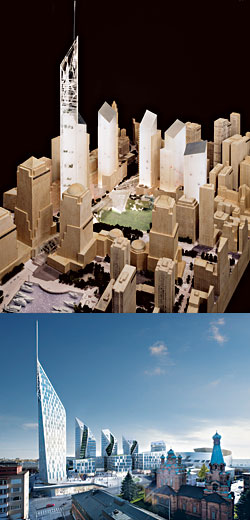
Bottom: Libeskind’s nearly identical mid-rise variation on his original design, slated to be constructed in Finland in 2018.Photo: Jack Pottle/Esto; Rendering Courtesy of Studio Daniel Libeskind for NCC
To this day, the Rector Street offices of Daniel Libeskind are dominated by a pool-table-size wooden model of downtown, centered on his 2003 winning design for how the World Trade Center site was to be rebuilt. The plan stands out like a mirage in translucent white plastic, a spiral of buildings, their slanted roofs each deferring upward to the 1,776-foot-tall off-center spire of what became known, for a while, as the Freedom Tower. It doesn’t look much like what is going up a couple of blocks north, though Libeskind believes the essential design of the site is still his: “I think of course the project has evolved, but all the symbols and all the meanings are actually there,” he said in an interview on August 17. His plan, called “Memory Foundations,” was festooned with symbolism: He wanted to expose the 70-foot-deep “slurry wall” (a.k.a. the bathtub that held back the Hudson) that, he said at the time, “stands as eloquent as the Constitution itself asserting the durability of democracy.” There was to be a “Park of Heroes” and a plaza called the “Wedge of Light,” which would align with the sun on the anniversary of the attacks. Most important, he imagined an asymmetrical tower at the northwest corner, its form inspired by the Statue of Liberty’s torch—which he first saw at 13, in 1959, when he arrived by ship from Poland. Libeskind evangelized fervently for his masterpiece, even on Oprah. He persuaded Governor Pataki to choose his over the proposal by a consortium called THINK, headed by Rafael Viñoly, which consisted of twin 1,440-foot-tall latticework towers Libeskind derided as “skeletons in the sky” and which was originally preferred by the selection committee. Libeskind, who’d hired publicist Howard Rubenstein to plead his side, was then confronted with the fact that neither the memorial nor the Freedom Tower was his to design—though he’d designed versions of both. The center’s leaseholder, Larry Silverstein, had his own architect, David Childs, of the big corporate firm Skidmore, Owings & Merrill, and told Libeskind he wasn’t experienced enough as a skyscraper architect (Childs, for his part, dismissed Libeskind’s design as a “bayonet”). Libeskind hired lawyer Ed Hayes, and Pataki eventually pressed for a compromise, but the One World Trade Center now going up, which Childs likens to the Washington Monument, has only its height in common with Libeskind’s dream. And yet through all of this, Libeskind became a far more famous architect, a designer of skyscrapers, and a man who claims to enjoy the very clash of interests that nearly squeezed him out. “It’s not about ‘Here’s a building, here’s a building, here’s a memorial,’ but to create an urban space of memory,” he said. Comparing his original drawing with the current renderings, he added, “It’s so close; it’s amazing how close it is to the sketch.”
From the archives
• Disappearing Act (New York Magazine, October 20, 2003)
• Winner Takes What? (New York Magazine, March 10, 2003)
